Page 210 of 561

209 Controls in detail
Good visibility
Auto-dimming rear view mirrors*
The reflection brightness of the exterior
rear view mirror on the driver’s side and
the interior rear view mirror will respond
automatically to glare when�
the ignition is switched on
�
incoming light from headlamps falls on
the sensor in the interior rear view
mirror
The rear view mirror will not react if
�
reverse gearR is engaged
�
the interior light is turned on
Warning!
G
The auto-dimming function does not react if
incoming light is not aimed directly at sen-
sors in the interior rear view mirror.
The interior rear view mirror and the exterior
rear view mirror on the driver’s side do not
react, for example, when transporting cargo
which covers the rear window.
Glare can endanger you and others.Warning!
G
In case of an accident liquid electrolyte may
escape from the mirror housing if the mirror
glass breaks.
Electrolyte has an irritating effect. Do not
allow the liquid to come into contact with
eyes, skin, clothing, or respiratory system.
In case it does, immediately flush affected
area with water, and seek medical help if
necessary.
!Electrolyte drops coming into contact
with the vehicle paint finish can be
completely removed only while in the
liquid state and by applying plenty of
water.Warning!
G
Exercise care when using the passen-
ger-side exterior rear view mirror. The mirror
surface is convex (outwardly curved surface
for a wider field of view). Objects in mirror
are closer than they appear. Check your
interior rear view mirror or glance over your
shoulder before changing lanes.
Page 214 of 561
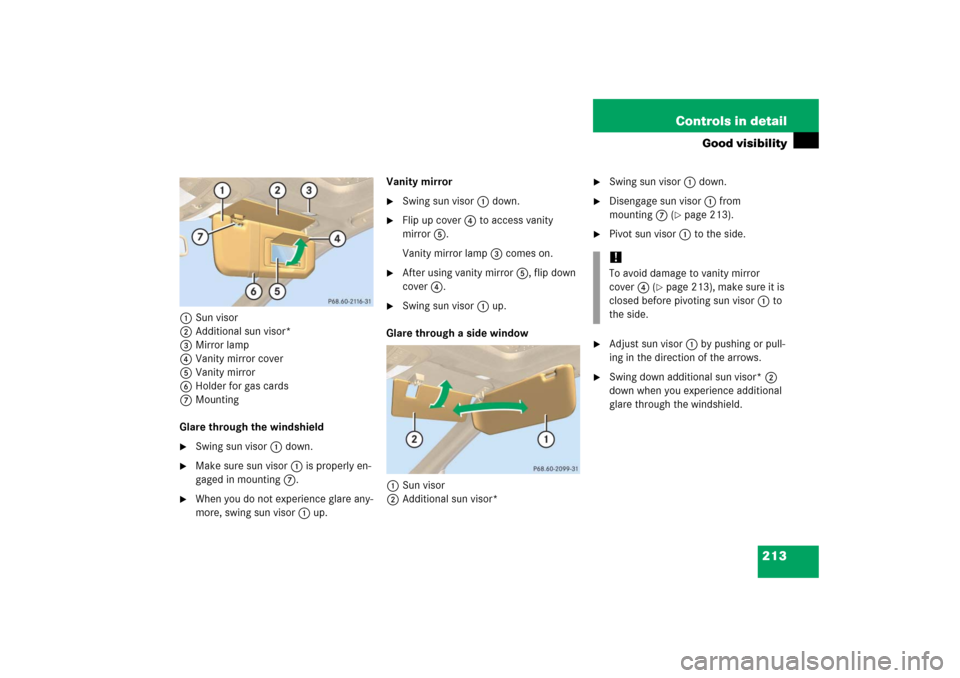
213 Controls in detail
Good visibility
1Sun visor
2Additional sun visor*
3Mirror lamp
4Vanity mirror cover
5Vanity mirror
6Holder for gas cards
7Mounting
Glare through the windshield�
Swing sun visor1 down.
�
Make sure sun visor 1 is properly en-
gaged in mounting 7.
�
When you do not experience glare any-
more, swing sun visor 1 up.Vanity mirror
�
Swing sun visor1 down.
�
Flip up cover4 to access vanity
mirror5.
Vanity mirror lamp3 comes on.
�
After using vanity mirror 5, flip down
cover4.
�
Swing sun visor 1 up.
Glare through a side window
1Sun visor
2Additional sun visor*
�
Swing sun visor1 down.
�
Disengage sun visor1 from
mounting7 (
�page 213).
�
Pivot sun visor1 to the side.
�
Adjust sun visor 1 by pushing or pull-
ing in the direction of the arrows.
�
Swing down additional sun visor*2
down when you experience additional
glare through the windshield.!To avoid damage to vanity mirror
cover4 (
�page 213), make sure it is
closed before pivoting sun visor 1 to
the side.
Page 215 of 561
214 Controls in detailGood visibilityRear door window sunshade*
1Holder
2Tab�
To raise sunshade, pull on tab 2 and
engage it in holder 1.
�
To lower sunshade, disengage tab 2
from holder 1 and guide retraction.
Third-row sunshade*
1Clip
2Mounting�
Insert clips 1 into mountings 2.
�
Press on clips 1 to engage in mount-
ings 2.
!Always guide the sunshade. Do not let
it snap back abruptly, as the retractor
could be damaged.!With the sunshade raised and the
respective door window open, the sun-
shade could disengage and snap back
when driving at high vehicle speeds,
e.g. on highways, and damage the
retractor. You should therefore always
either close the door window or lower
the sunshade when driving at high
speed.
Page 216 of 561
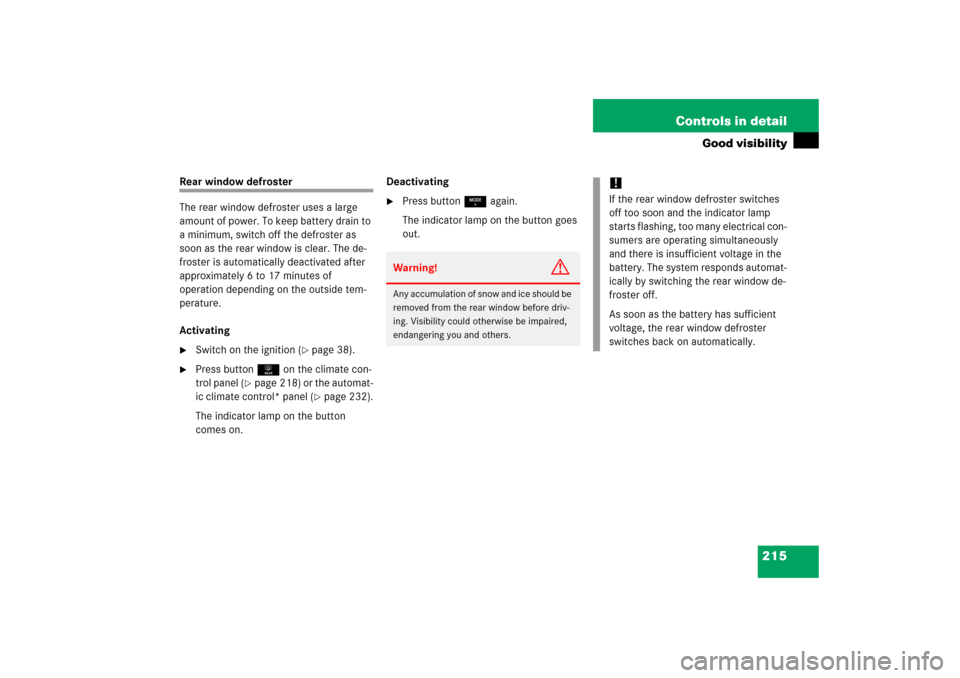
215 Controls in detail
Good visibility
Rear window defroster
The rear window defroster uses a large
amount of power. To keep battery drain to
a minimum, switch off the defroster as
soon as the rear window is clear. The de-
froster is automatically deactivated after
approximately 6 to 17 minutes of
operation depending on the outside tem-
perature.
Activating�
Switch on the ignition (
�page 38).
�
Press button1 on the climate con-
trol panel (
�page 218) or the automat-
ic climate control* panel (
�page 232).
The indicator lamp on the button
comes on.Deactivating
�
Press button3 again.
The indicator lamp on the button goes
out.Warning!
G
Any accumulation of snow and ice should be
removed from the rear window before driv-
ing. Visibility could otherwise be impaired,
endangering you and others.
!If the rear window defroster switches
off too soon and the indicator lamp
starts flashing, too many electrical con-
sumers are operating simultaneously
and there is insufficient voltage in the
battery. The system responds automat-
ically by switching the rear window de-
froster off.
As soon as the battery has sufficient
voltage, the rear window defroster
switches back on automatically.
Page 219 of 561
218 Controls in detailClimate control
1
Temperature control, left
2
Air distribution and air volume
(automatic, manual)
3
Front defroster
0USA only
P Canada only
4
Increasing air volume
5
Air distribution (directs air through
the windshield and side air vents)
6
Rear air conditioning on/off
:USA only
7
Temperature control, right
8
AC cooling on/off (A/C)
Residual heat/ventilation (REST)
9
Air distribution (directs air through
center and side air vents)
a
Air distribution (directs air through
the footwells and side vents)
b
Air volume display
c
Decreasing air volume
d
Rear window defroster
1 USA only
F Canada only
e
Air recirculation
f
Interior temperature sensor
g
Climate control on/off
Page 220 of 561
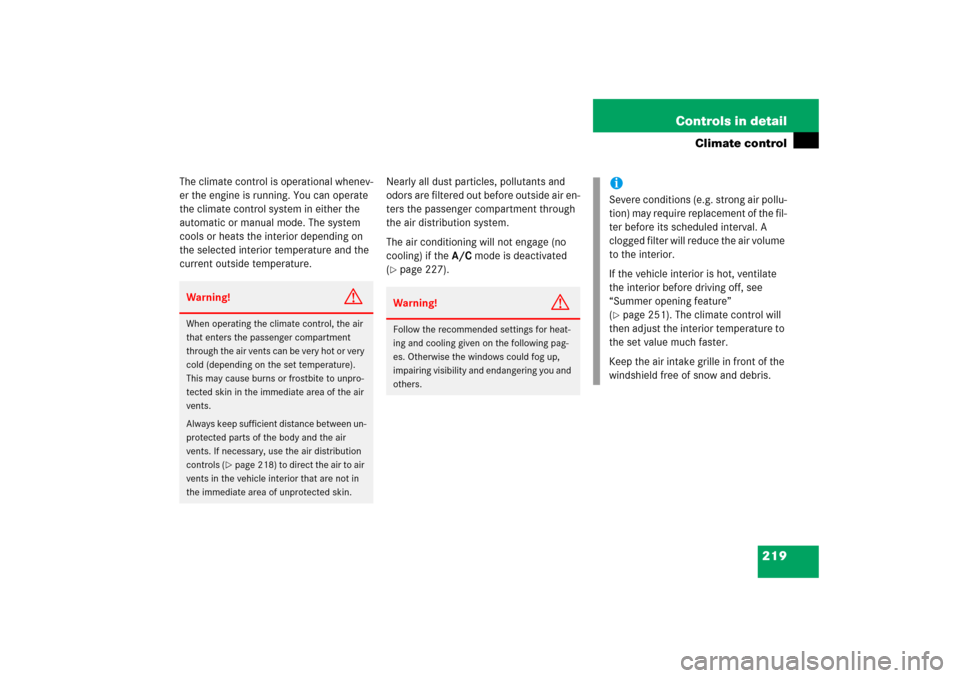
219 Controls in detail
Climate control
The climate control is operational whenev-
er the engine is running. You can operate
the climate control system in either the
automatic or manual mode. The system
cools or heats the interior depending on
the selected interior temperature and the
current outside temperature.Nearly all dust particles, pollutants and
odors are filtered out before outside air en-
ters the passenger compartment through
the air distribution system.
The air conditioning will not engage (no
cooling) if the A/C mode is deactivated
(
�page 227).
Warning!
G
When operating the climate control, the air
that enters the passenger compartment
through the air vents can be very hot or very
cold (depending on the set temperature).
This may cause burns or frostbite to unpro-
tected skin in the immediate area of the air
vents.
Always keep sufficient distance between un-
protected parts of the body and the air
vents. If necessary, use the air distribution
controls (
�page 218) to direct the air to air
vents in the vehicle interior that are not in
the immediate area of unprotected skin.
Warning!
G
Follow the recommended settings for heat-
ing and cooling given on the following pag-
es. Otherwise the windows could fog up,
impairing visibility and endangering you and
others.
iSevere conditions (e.g. strong air pollu-
tion) may require replacement of the fil-
ter before its scheduled interval. A
clogged filter will reduce the air volume
to the interior.
If the vehicle interior is hot, ventilate
the interior before driving off, see
“Summer opening feature”
(�page 251). The climate control will
then adjust the interior temperature to
the set value much faster.
Keep the air intake grille in front of the
windshield free of snow and debris.
Page 221 of 561
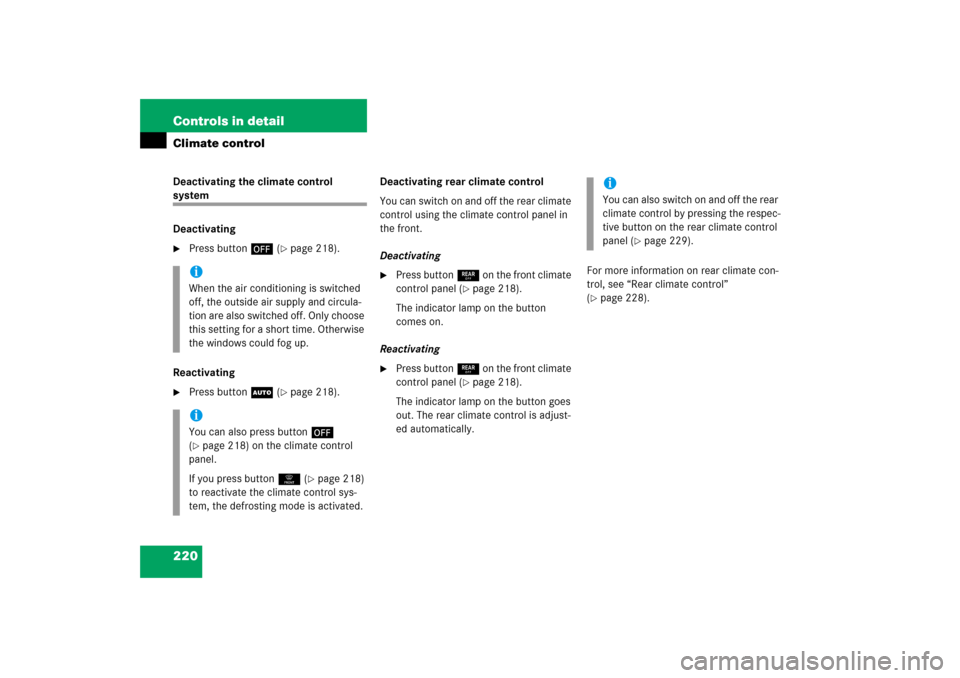
220 Controls in detailClimate controlDeactivating the climate control system
Deactivating�
Press button´ (
�page 218).
Reactivating
�
Press buttonU (
�page 218).Deactivating rear climate control
You can switch on and off the rear climate
control using the climate control panel in
the front.
Deactivating
�
Press button: on the front climate
control panel (
�page 218).
The indicator lamp on the button
comes on.
Reactivating
�
Press button: on the front climate
control panel (
�page 218).
The indicator lamp on the button goes
out. The rear climate control is adjust-
ed automatically.For more information on rear climate con-
trol, see “Rear climate control”
(
�page 228).
iWhen the air conditioning is switched
off, the outside air supply and circula-
tion are also switched off. Only choose
this setting for a short time. Otherwise
the windows could fog up.iYou can also press button´
(�page 218) on the climate control
panel.
If you press button0 (
�page 218)
to reactivate the climate control sys-
tem, the defrosting mode is activated.
iYou can also switch on and off the rear
climate control by pressing the respec-
tive button on the rear climate control
panel (
�page 229).
Page 224 of 561
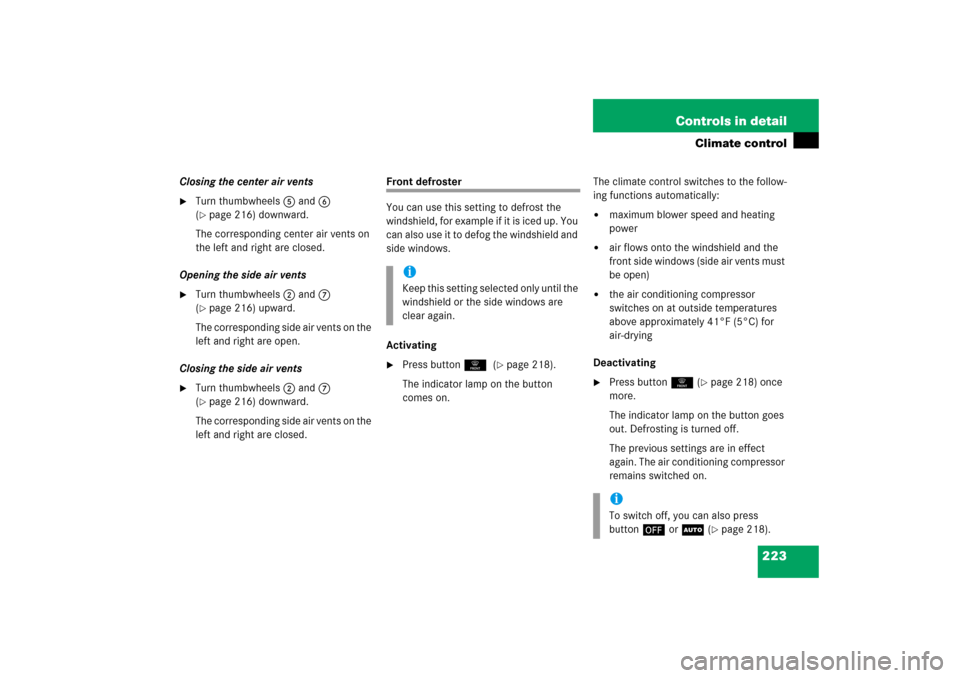
223 Controls in detail
Climate control
Closing the center air vents�
Turn thumbwheels 5 and 6
(�page 216) downward.
The corresponding center air vents on
the left and right are closed.
Opening the side air vents
�
Turn thumbwheels 2 and 7
(�page 216) upward.
The corresponding side air vents on the
left and right are open.
Closing the side air vents
�
Turn thumbwheels 2 and 7
(�page 216) downward.
The corresponding side air vents on the
left and right are closed.
Front defroster
You can use this setting to defrost the
windshield, for example if it is iced up. You
can also use it to defog the windshield and
side windows.
Activating�
Press button0 (
�page 218).
The indicator lamp on the button
comes on.The climate control switches to the follow-
ing functions automatically:
�
maximum blower speed and heating
power
�
air flows onto the windshield and the
front side windows (side air vents must
be open)
�
the air conditioning compressor
switches on at outside temperatures
above approximately 41°F (5°C) for
air-drying
Deactivating
�
Press button0 (
�page 218) once
more.
The indicator lamp on the button goes
out. Defrosting is turned off.
The previous settings are in effect
again. The air conditioning compressor
remains switched on.
iKeep this setting selected only until the
windshield or the side windows are
clear again.
iTo switch off, you can also press
button´ orU (
�page 218).